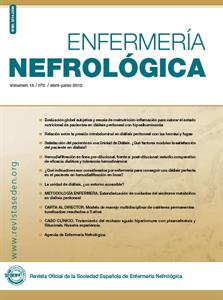Contenido del artículo principal
Resumen
El trasplante renal consiste en la extracción de un riñón de un individuo sano y su colocación en un paciente con insuficiencia renal crónica terminal1. El rechazo inmunológico es la principal complicación tras el trasplante. Se denomina rechazo al conjunto de manifestaciones clínicas, funcionales, anatomopatológicas, que pueden aparecer en un receptor de trasplante renal, como consecuencia de la activación del sistema inmune contra el injerto. El rechazo puede aparecer desde el momento de revascularización del órgano hasta años más tarde2. La incidencia del rechazo dependerá esencialmente de dos factores: las características del receptor y el tratamiento inmunosupresor utilizado. En general se acepta que un 30-40% de los pacientes desarrollan algún episodio de rechazo en el trasplante inmediato (3 primeros meses)1. En la mayoría de los protocolos se utilizan como tratamiento convencional bolos de metil-prednisolona a dosis que varían entre 250 y 1.000mg/día, durante 3-4 días. Con esta pauta se consigue respuesta entre el 60-70% de los casos. En el resto de los casos se habla de rechazo corticoresistente2. La Plasmaferesis ha sido recientemente introducida en el tratamiento del rechazo agudo del trasplante renal resistente al tratamiento convencional con esteroides3. La aféresis puede definirse como una modalidad terapéutica que consiste en la extracción de un volumen determinado de plasma (de 2 a 5 litros) con el fin de eliminar aquellos patógenos considerados responsables de una enfermedad o bien sus manifestaciones clínicas. El recambio plasmático mediante filtración a través de membranas se realiza mediante el montaje de un circuito extracorpóreo.
Palabras clave
Detalles del artículo
Derechos de autor 2012 Raquel Pérez Uceta, Mª Esther Llorente Sansano, Mª de los Ángeles Gálvez Velasco, Joseba Iñaki Angüero Jurado, Gema Briceño Sánchez, Mª Isabel Bravo Moreno

Esta obra está bajo una licencia internacional Creative Commons Atribución-NoComercial 4.0.
Aviso de derechos de autor/a
© Los autores ceden de forma no exclusiva los derechos de explotación de los trabajos publicados y consiente en que su uso y distribución se realice con la Licencia Creative Commons Atribución - No comercial 4.0 Internacional (CC BY-NC 4.0). Puede consultar desde aquí la versión informativa y el texto legal de la licencia. Esta circunstancia ha de hacerse constar expresamente de esta forma cuando sea necesario.
Referencias
- Andreu Periz L, Force Sanmartin E. 500 cuestiones que plantea el cuidado del enfermo renal. 2ª Edición. Barcelona: Masson; 2001.
- Andreu Periz L, Force Sanmartin E. La enfermería y el trasplante de órganos. Madrid: Médica Panamericana; 2004.
- Herrera, L; Soto, I; Sequí, M.J.; Fernández, A. Efecto de la plasmaféresis en el tratamiento del rechazo agudo resistente al tratamiento convencional. En: El libro de ponencias: 8ª Reunión Nacional de la Sociedad Española de ATS de nefrología. Oviedo 12-15 de octubre, 1983.p.51-57. Disponible en : hhtp://:www.seden.org.
- De la Vara Almonacid, J.A.; García Estévez, S, et al. Plasmaféresis como tratamiento de enfermedades renales. Experiencia de 16 años en un centro. En: El libro de ponencias: XXXII Congreso Nacional de la Sociedad Española de Enfermería Nefrológica. Cádiz 3-6 de octubre, 2007. Barcelona: Hospal; 2007. p. 99-102.
- Anaya F. Aféresis Terapéutica. Madrid. Norma- Capitel.2005.6. Sastre A, Baños M, Seco M, Gómez Huertas E. Recidiva de vasculitis en trasplante renal tratada con rituximab. Nefrología. 2007; 27 (5): 645-646.
- Fernández-Fresnedo G, López hoyos M, Arias M. Rituximab en el tratamiento de las enfermedades glomerulares. NefroPlus. 2009; 2(3): 24-33.
Referencias
Andreu Periz L, Force Sanmartin E. 500 cuestiones que plantea el cuidado del enfermo renal. 2ª Edición. Barcelona: Masson; 2001.
Andreu Periz L, Force Sanmartin E. La enfermería y el trasplante de órganos. Madrid: Médica Panamericana; 2004.
Herrera, L; Soto, I; Sequí, M.J.; Fernández, A. Efecto de la plasmaféresis en el tratamiento del rechazo agudo resistente al tratamiento convencional. En: El libro de ponencias: 8ª Reunión Nacional de la Sociedad Española de ATS de nefrología. Oviedo 12-15 de octubre, 1983.p.51-57. Disponible en : hhtp://:www.seden.org.
De la Vara Almonacid, J.A.; García Estévez, S, et al. Plasmaféresis como tratamiento de enfermedades renales. Experiencia de 16 años en un centro. En: El libro de ponencias: XXXII Congreso Nacional de la Sociedad Española de Enfermería Nefrológica. Cádiz 3-6 de octubre, 2007. Barcelona: Hospal; 2007. p. 99-102.
Anaya F. Aféresis Terapéutica. Madrid. Norma- Capitel.2005.6. Sastre A, Baños M, Seco M, Gómez Huertas E. Recidiva de vasculitis en trasplante renal tratada con rituximab. Nefrología. 2007; 27 (5): 645-646.
Fernández-Fresnedo G, López hoyos M, Arias M. Rituximab en el tratamiento de las enfermedades glomerulares. NefroPlus. 2009; 2(3): 24-33.




